Essay: Stereotypical Portrayal and Its Impact in Advertisement (2019)
VerifiedAdded on 2023/01/05
|6
|1662
|48
Essay
AI Summary
This essay critically examines the stereotypical portrayals presented in the Australian Day Lamb Ad 2019. The essay begins by introducing the advertisement and outlining its controversial reception. It then delves into the specific arguments presented within the ad, such as the depiction of historical events, cultural comparisons between Australia and New Zealand, and the use of exaggerated accents and attire to reinforce stereotypes. The analysis explores how the advertisement's approach backfired, promoting an unequal status between countries. The essay further discusses the lack of innovation in the ad's approach, which relies on traditional and borrowed concepts of media portrayals. The essay argues for the need to resist stereotypical notions and embrace diversity within communities. The conclusion emphasizes the importance of innovation in advertising and the need for businesses to adapt to societal changes to achieve commercial success.
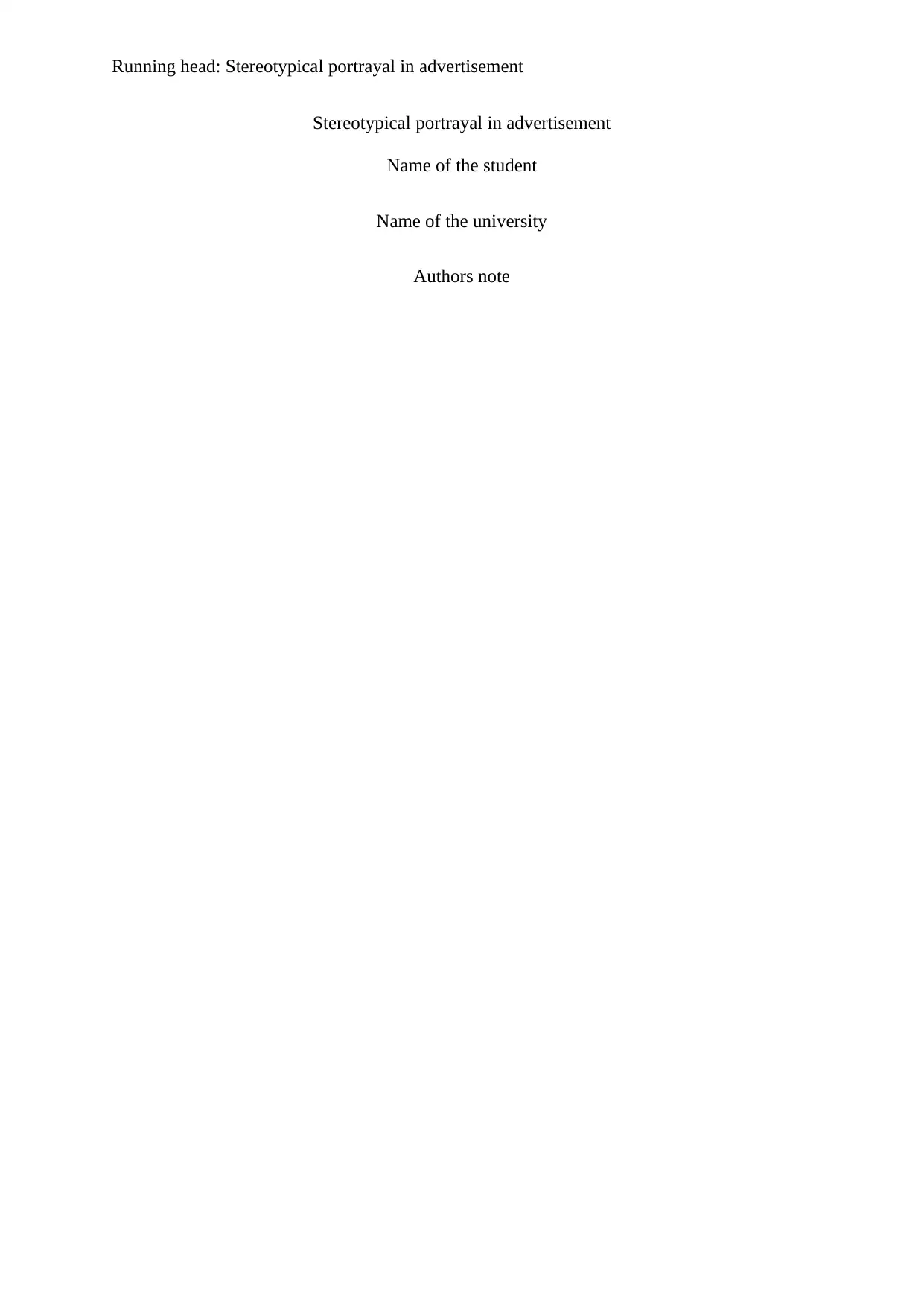
Running head: Stereotypical portrayal in advertisement
Stereotypical portrayal in advertisement
Name of the student
Name of the university
Authors note
Stereotypical portrayal in advertisement
Name of the student
Name of the university
Authors note
Paraphrase This Document
Need a fresh take? Get an instant paraphrase of this document with our AI Paraphraser
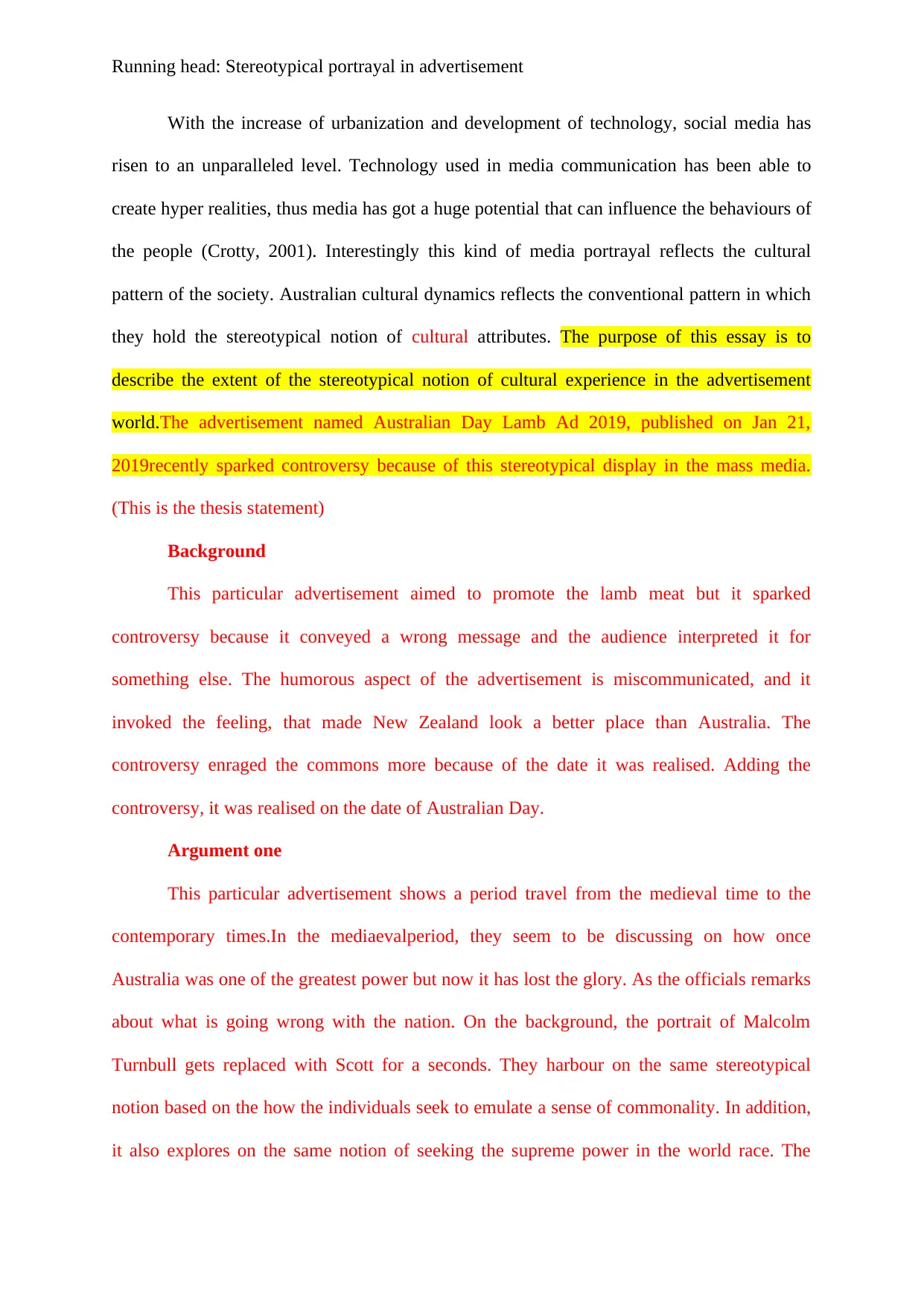
Running head: Stereotypical portrayal in advertisement
With the increase of urbanization and development of technology, social media has
risen to an unparalleled level. Technology used in media communication has been able to
create hyper realities, thus media has got a huge potential that can influence the behaviours of
the people (Crotty, 2001). Interestingly this kind of media portrayal reflects the cultural
pattern of the society. Australian cultural dynamics reflects the conventional pattern in which
they hold the stereotypical notion of cultural attributes. The purpose of this essay is to
describe the extent of the stereotypical notion of cultural experience in the advertisement
world.The advertisement named Australian Day Lamb Ad 2019, published on Jan 21,
2019recently sparked controversy because of this stereotypical display in the mass media.
(This is the thesis statement)
Background
This particular advertisement aimed to promote the lamb meat but it sparked
controversy because it conveyed a wrong message and the audience interpreted it for
something else. The humorous aspect of the advertisement is miscommunicated, and it
invoked the feeling, that made New Zealand look a better place than Australia. The
controversy enraged the commons more because of the date it was realised. Adding the
controversy, it was realised on the date of Australian Day.
Argument one
This particular advertisement shows a period travel from the medieval time to the
contemporary times.In the mediaevalperiod, they seem to be discussing on how once
Australia was one of the greatest power but now it has lost the glory. As the officials remarks
about what is going wrong with the nation. On the background, the portrait of Malcolm
Turnbull gets replaced with Scott for a seconds. They harbour on the same stereotypical
notion based on the how the individuals seek to emulate a sense of commonality. In addition,
it also explores on the same notion of seeking the supreme power in the world race. The
With the increase of urbanization and development of technology, social media has
risen to an unparalleled level. Technology used in media communication has been able to
create hyper realities, thus media has got a huge potential that can influence the behaviours of
the people (Crotty, 2001). Interestingly this kind of media portrayal reflects the cultural
pattern of the society. Australian cultural dynamics reflects the conventional pattern in which
they hold the stereotypical notion of cultural attributes. The purpose of this essay is to
describe the extent of the stereotypical notion of cultural experience in the advertisement
world.The advertisement named Australian Day Lamb Ad 2019, published on Jan 21,
2019recently sparked controversy because of this stereotypical display in the mass media.
(This is the thesis statement)
Background
This particular advertisement aimed to promote the lamb meat but it sparked
controversy because it conveyed a wrong message and the audience interpreted it for
something else. The humorous aspect of the advertisement is miscommunicated, and it
invoked the feeling, that made New Zealand look a better place than Australia. The
controversy enraged the commons more because of the date it was realised. Adding the
controversy, it was realised on the date of Australian Day.
Argument one
This particular advertisement shows a period travel from the medieval time to the
contemporary times.In the mediaevalperiod, they seem to be discussing on how once
Australia was one of the greatest power but now it has lost the glory. As the officials remarks
about what is going wrong with the nation. On the background, the portrait of Malcolm
Turnbull gets replaced with Scott for a seconds. They harbour on the same stereotypical
notion based on the how the individuals seek to emulate a sense of commonality. In addition,
it also explores on the same notion of seeking the supreme power in the world race. The
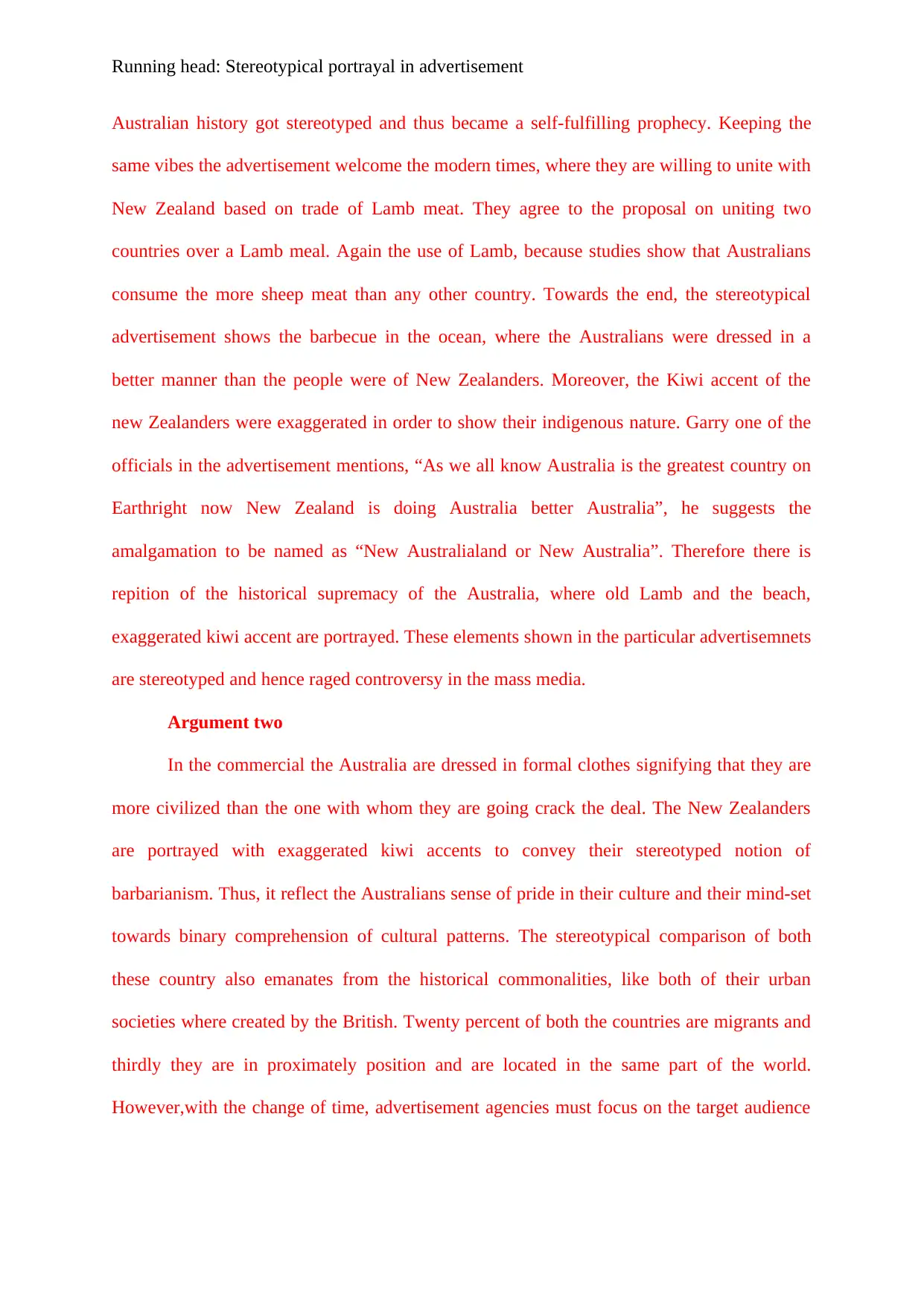
Running head: Stereotypical portrayal in advertisement
Australian history got stereotyped and thus became a self-fulfilling prophecy. Keeping the
same vibes the advertisement welcome the modern times, where they are willing to unite with
New Zealand based on trade of Lamb meat. They agree to the proposal on uniting two
countries over a Lamb meal. Again the use of Lamb, because studies show that Australians
consume the more sheep meat than any other country. Towards the end, the stereotypical
advertisement shows the barbecue in the ocean, where the Australians were dressed in a
better manner than the people were of New Zealanders. Moreover, the Kiwi accent of the
new Zealanders were exaggerated in order to show their indigenous nature. Garry one of the
officials in the advertisement mentions, “As we all know Australia is the greatest country on
Earthright now New Zealand is doing Australia better Australia”, he suggests the
amalgamation to be named as “New Australialand or New Australia”. Therefore there is
repition of the historical supremacy of the Australia, where old Lamb and the beach,
exaggerated kiwi accent are portrayed. These elements shown in the particular advertisemnets
are stereotyped and hence raged controversy in the mass media.
Argument two
In the commercial the Australia are dressed in formal clothes signifying that they are
more civilized than the one with whom they are going crack the deal. The New Zealanders
are portrayed with exaggerated kiwi accents to convey their stereotyped notion of
barbarianism. Thus, it reflect the Australians sense of pride in their culture and their mind-set
towards binary comprehension of cultural patterns. The stereotypical comparison of both
these country also emanates from the historical commonalities, like both of their urban
societies where created by the British. Twenty percent of both the countries are migrants and
thirdly they are in proximately position and are located in the same part of the world.
However,with the change of time, advertisement agencies must focus on the target audience
Australian history got stereotyped and thus became a self-fulfilling prophecy. Keeping the
same vibes the advertisement welcome the modern times, where they are willing to unite with
New Zealand based on trade of Lamb meat. They agree to the proposal on uniting two
countries over a Lamb meal. Again the use of Lamb, because studies show that Australians
consume the more sheep meat than any other country. Towards the end, the stereotypical
advertisement shows the barbecue in the ocean, where the Australians were dressed in a
better manner than the people were of New Zealanders. Moreover, the Kiwi accent of the
new Zealanders were exaggerated in order to show their indigenous nature. Garry one of the
officials in the advertisement mentions, “As we all know Australia is the greatest country on
Earthright now New Zealand is doing Australia better Australia”, he suggests the
amalgamation to be named as “New Australialand or New Australia”. Therefore there is
repition of the historical supremacy of the Australia, where old Lamb and the beach,
exaggerated kiwi accent are portrayed. These elements shown in the particular advertisemnets
are stereotyped and hence raged controversy in the mass media.
Argument two
In the commercial the Australia are dressed in formal clothes signifying that they are
more civilized than the one with whom they are going crack the deal. The New Zealanders
are portrayed with exaggerated kiwi accents to convey their stereotyped notion of
barbarianism. Thus, it reflect the Australians sense of pride in their culture and their mind-set
towards binary comprehension of cultural patterns. The stereotypical comparison of both
these country also emanates from the historical commonalities, like both of their urban
societies where created by the British. Twenty percent of both the countries are migrants and
thirdly they are in proximately position and are located in the same part of the world.
However,with the change of time, advertisement agencies must focus on the target audience
⊘ This is a preview!⊘
Do you want full access?
Subscribe today to unlock all pages.

Trusted by 1+ million students worldwide
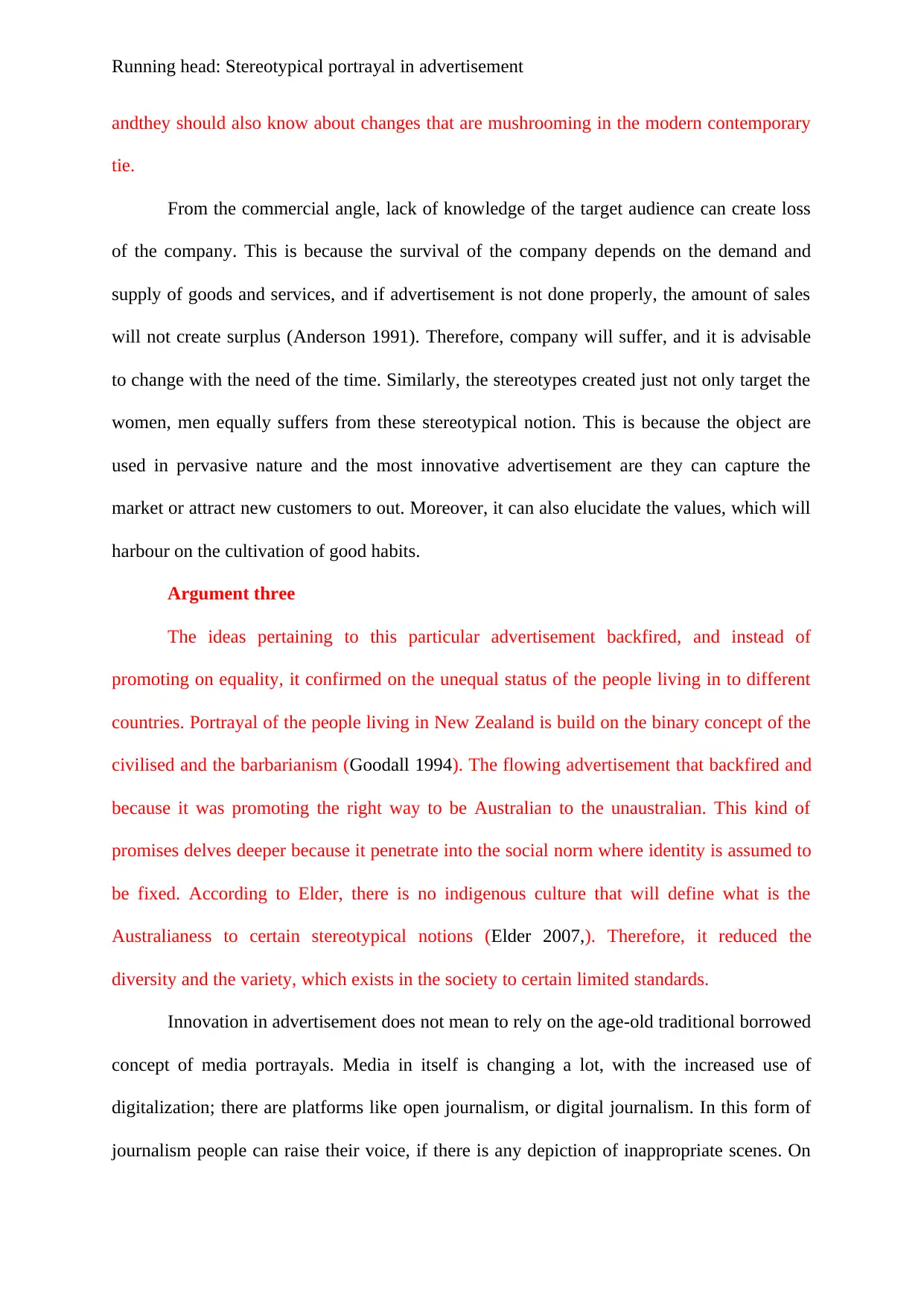
Running head: Stereotypical portrayal in advertisement
andthey should also know about changes that are mushrooming in the modern contemporary
tie.
From the commercial angle, lack of knowledge of the target audience can create loss
of the company. This is because the survival of the company depends on the demand and
supply of goods and services, and if advertisement is not done properly, the amount of sales
will not create surplus (Anderson 1991). Therefore, company will suffer, and it is advisable
to change with the need of the time. Similarly, the stereotypes created just not only target the
women, men equally suffers from these stereotypical notion. This is because the object are
used in pervasive nature and the most innovative advertisement are they can capture the
market or attract new customers to out. Moreover, it can also elucidate the values, which will
harbour on the cultivation of good habits.
Argument three
The ideas pertaining to this particular advertisement backfired, and instead of
promoting on equality, it confirmed on the unequal status of the people living in to different
countries. Portrayal of the people living in New Zealand is build on the binary concept of the
civilised and the barbarianism (Goodall 1994). The flowing advertisement that backfired and
because it was promoting the right way to be Australian to the unaustralian. This kind of
promises delves deeper because it penetrate into the social norm where identity is assumed to
be fixed. According to Elder, there is no indigenous culture that will define what is the
Australianess to certain stereotypical notions (Elder 2007,). Therefore, it reduced the
diversity and the variety, which exists in the society to certain limited standards.
Innovation in advertisement does not mean to rely on the age-old traditional borrowed
concept of media portrayals. Media in itself is changing a lot, with the increased use of
digitalization; there are platforms like open journalism, or digital journalism. In this form of
journalism people can raise their voice, if there is any depiction of inappropriate scenes. On
andthey should also know about changes that are mushrooming in the modern contemporary
tie.
From the commercial angle, lack of knowledge of the target audience can create loss
of the company. This is because the survival of the company depends on the demand and
supply of goods and services, and if advertisement is not done properly, the amount of sales
will not create surplus (Anderson 1991). Therefore, company will suffer, and it is advisable
to change with the need of the time. Similarly, the stereotypes created just not only target the
women, men equally suffers from these stereotypical notion. This is because the object are
used in pervasive nature and the most innovative advertisement are they can capture the
market or attract new customers to out. Moreover, it can also elucidate the values, which will
harbour on the cultivation of good habits.
Argument three
The ideas pertaining to this particular advertisement backfired, and instead of
promoting on equality, it confirmed on the unequal status of the people living in to different
countries. Portrayal of the people living in New Zealand is build on the binary concept of the
civilised and the barbarianism (Goodall 1994). The flowing advertisement that backfired and
because it was promoting the right way to be Australian to the unaustralian. This kind of
promises delves deeper because it penetrate into the social norm where identity is assumed to
be fixed. According to Elder, there is no indigenous culture that will define what is the
Australianess to certain stereotypical notions (Elder 2007,). Therefore, it reduced the
diversity and the variety, which exists in the society to certain limited standards.
Innovation in advertisement does not mean to rely on the age-old traditional borrowed
concept of media portrayals. Media in itself is changing a lot, with the increased use of
digitalization; there are platforms like open journalism, or digital journalism. In this form of
journalism people can raise their voice, if there is any depiction of inappropriate scenes. On
Paraphrase This Document
Need a fresh take? Get an instant paraphrase of this document with our AI Paraphraser
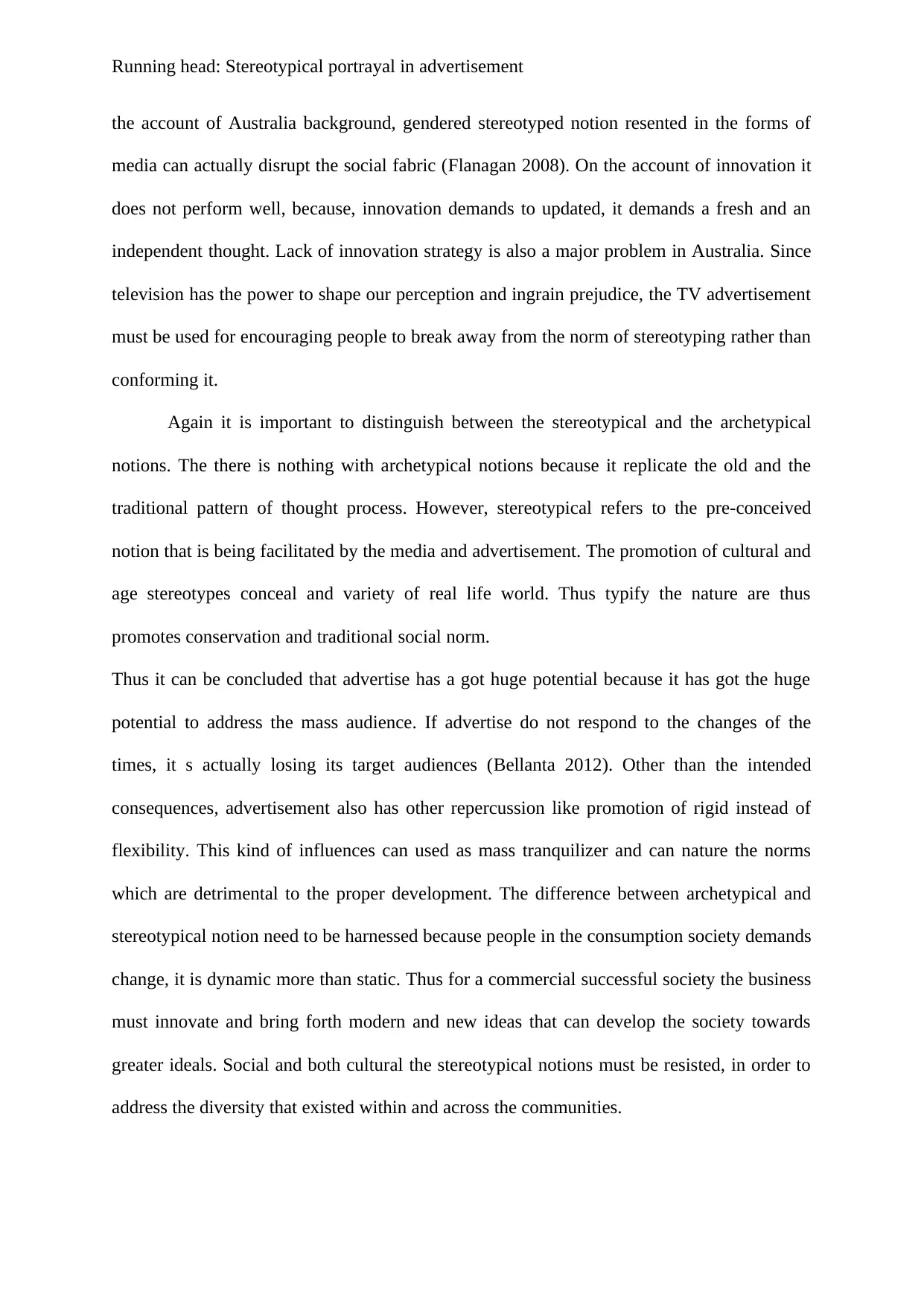
Running head: Stereotypical portrayal in advertisement
the account of Australia background, gendered stereotyped notion resented in the forms of
media can actually disrupt the social fabric (Flanagan 2008). On the account of innovation it
does not perform well, because, innovation demands to updated, it demands a fresh and an
independent thought. Lack of innovation strategy is also a major problem in Australia. Since
television has the power to shape our perception and ingrain prejudice, the TV advertisement
must be used for encouraging people to break away from the norm of stereotyping rather than
conforming it.
Again it is important to distinguish between the stereotypical and the archetypical
notions. The there is nothing with archetypical notions because it replicate the old and the
traditional pattern of thought process. However, stereotypical refers to the pre-conceived
notion that is being facilitated by the media and advertisement. The promotion of cultural and
age stereotypes conceal and variety of real life world. Thus typify the nature are thus
promotes conservation and traditional social norm.
Thus it can be concluded that advertise has a got huge potential because it has got the huge
potential to address the mass audience. If advertise do not respond to the changes of the
times, it s actually losing its target audiences (Bellanta 2012). Other than the intended
consequences, advertisement also has other repercussion like promotion of rigid instead of
flexibility. This kind of influences can used as mass tranquilizer and can nature the norms
which are detrimental to the proper development. The difference between archetypical and
stereotypical notion need to be harnessed because people in the consumption society demands
change, it is dynamic more than static. Thus for a commercial successful society the business
must innovate and bring forth modern and new ideas that can develop the society towards
greater ideals. Social and both cultural the stereotypical notions must be resisted, in order to
address the diversity that existed within and across the communities.
the account of Australia background, gendered stereotyped notion resented in the forms of
media can actually disrupt the social fabric (Flanagan 2008). On the account of innovation it
does not perform well, because, innovation demands to updated, it demands a fresh and an
independent thought. Lack of innovation strategy is also a major problem in Australia. Since
television has the power to shape our perception and ingrain prejudice, the TV advertisement
must be used for encouraging people to break away from the norm of stereotyping rather than
conforming it.
Again it is important to distinguish between the stereotypical and the archetypical
notions. The there is nothing with archetypical notions because it replicate the old and the
traditional pattern of thought process. However, stereotypical refers to the pre-conceived
notion that is being facilitated by the media and advertisement. The promotion of cultural and
age stereotypes conceal and variety of real life world. Thus typify the nature are thus
promotes conservation and traditional social norm.
Thus it can be concluded that advertise has a got huge potential because it has got the huge
potential to address the mass audience. If advertise do not respond to the changes of the
times, it s actually losing its target audiences (Bellanta 2012). Other than the intended
consequences, advertisement also has other repercussion like promotion of rigid instead of
flexibility. This kind of influences can used as mass tranquilizer and can nature the norms
which are detrimental to the proper development. The difference between archetypical and
stereotypical notion need to be harnessed because people in the consumption society demands
change, it is dynamic more than static. Thus for a commercial successful society the business
must innovate and bring forth modern and new ideas that can develop the society towards
greater ideals. Social and both cultural the stereotypical notions must be resisted, in order to
address the diversity that existed within and across the communities.
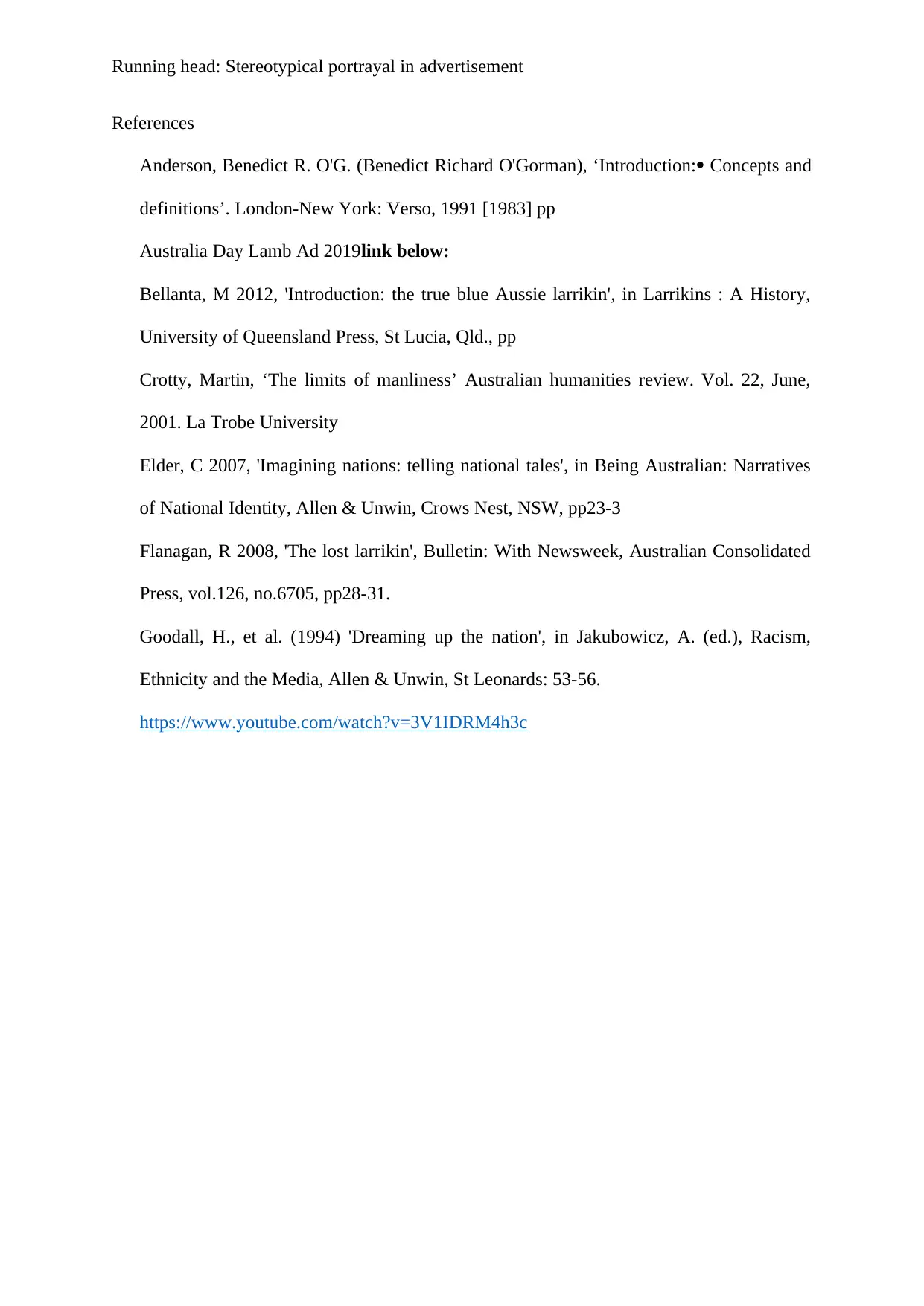
Running head: Stereotypical portrayal in advertisement
References
Anderson, Benedict R. O'G. (Benedict Richard O'Gorman), ‘Introduction: Concepts and
definitions’. London-New York: Verso, 1991 [1983] pp
Australia Day Lamb Ad 2019link below:
Bellanta, M 2012, 'Introduction: the true blue Aussie larrikin', in Larrikins : A History,
University of Queensland Press, St Lucia, Qld., pp
Crotty, Martin, ‘The limits of manliness’ Australian humanities review. Vol. 22, June,
2001. La Trobe University
Elder, C 2007, 'Imagining nations: telling national tales', in Being Australian: Narratives
of National Identity, Allen & Unwin, Crows Nest, NSW, pp23-3
Flanagan, R 2008, 'The lost larrikin', Bulletin: With Newsweek, Australian Consolidated
Press, vol.126, no.6705, pp28-31.
Goodall, H., et al. (1994) 'Dreaming up the nation', in Jakubowicz, A. (ed.), Racism,
Ethnicity and the Media, Allen & Unwin, St Leonards: 53-56.
https://www.youtube.com/watch?v=3V1IDRM4h3c
References
Anderson, Benedict R. O'G. (Benedict Richard O'Gorman), ‘Introduction: Concepts and
definitions’. London-New York: Verso, 1991 [1983] pp
Australia Day Lamb Ad 2019link below:
Bellanta, M 2012, 'Introduction: the true blue Aussie larrikin', in Larrikins : A History,
University of Queensland Press, St Lucia, Qld., pp
Crotty, Martin, ‘The limits of manliness’ Australian humanities review. Vol. 22, June,
2001. La Trobe University
Elder, C 2007, 'Imagining nations: telling national tales', in Being Australian: Narratives
of National Identity, Allen & Unwin, Crows Nest, NSW, pp23-3
Flanagan, R 2008, 'The lost larrikin', Bulletin: With Newsweek, Australian Consolidated
Press, vol.126, no.6705, pp28-31.
Goodall, H., et al. (1994) 'Dreaming up the nation', in Jakubowicz, A. (ed.), Racism,
Ethnicity and the Media, Allen & Unwin, St Leonards: 53-56.
https://www.youtube.com/watch?v=3V1IDRM4h3c
⊘ This is a preview!⊘
Do you want full access?
Subscribe today to unlock all pages.

Trusted by 1+ million students worldwide
1 out of 6
Your All-in-One AI-Powered Toolkit for Academic Success.
+13062052269
info@desklib.com
Available 24*7 on WhatsApp / Email
![[object Object]](/_next/static/media/star-bottom.7253800d.svg)
Unlock your academic potential
Copyright © 2020–2025 A2Z Services. All Rights Reserved. Developed and managed by ZUCOL.